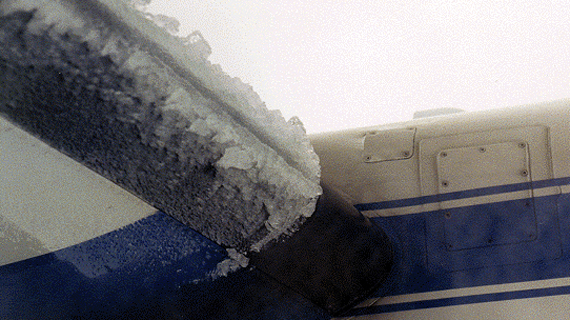

Icing conditions are a critical a safety issue which can lead to a major disaster quickly.
WHAT IS THE RISK?
Ice buildup can transform the shape of the aircraft. Because wings help create lift in an aircraft, any change of shape will impact lift, drag and controllability and could make the plane impossible to fly. Ice can also clog delicate instrument sensors. When critical sensors like Airspeed Indicators become clogged or frozen, the chance for recovery is drastically reduced because an increase in airspeed is essential to maintianing altitude.
Experienced pilots first try to avoid icing conditions. Accurate weather information and prediction is essential. An experienced pilot operating an equipped aircraft can navigate through certain icing conditions with much less risk of disaster. With proper training, an pilot can enter icing conditions and maintain lift by increasing speed and changing altitude and angle of flight.
An inexperienced pilot may find the essential navigating commands in icing conditions as counter-intuitive, which is why training is so important. A plane without deicing equipment and frozen sensors leaves the pilot with only the sound of the propellor to guess airspeed. It's a very risky situation.
Aircraft can be outfitted with equipment which either melt ice from the wings leading edge, or break up accumulations. Not all deicing equipment does as good a job at deicing, and unfortunately the FAA has not required manufacturers to deal with the issue, nor require commercial aviation companies to invest in retrofitted deicing equipment.
The NTSB has listed response to Aircraft Icing as a critical safety hazard which the FAA has failed to address in over 10 years. The NTSB is a science-based organization who's data is produced by catastrophic failures and air disasters. The FAA is patently ignoring their scientific findings and recommendations due to industry pressure.
WHAT SHOULD THE FAA DO TO LESSEN RISK TO PILOTS?
HOW CAN WE MITIGATE OR REDUCE THE RISK?
The solution to the risks introduced with Icing Conditions include:
TECHNICAL INFORMATION ON ICING EQUIPMENT
Anti-Ice Boot
Deicing Boots
Fluid Freeze Point Deicing Systems
Electric Thermal Deicers
Hot Compressed Air Systems
Electroexpulsive systems
FURTHER READING
Nasa's Free Pilot Training online guide to operating in Icing Conditions
http://aircrafticing.grc.nasa.gov/courses.html
AOPA's Quiz and guide to Icing Conditions
http://www.aopa.org/asf/hotspot/icing.html
AOPA Pilot's Real life story of Icing Conditions
http://flash.aopa.org/asf/pilotstories/icing/
AOPA Deicing Equipment Safety Spotlight
http://www.aopa.org/asf/publications/sa22.pdf
AOPA icing safety Spotlight for Pilots
http://www.aopa.org/asf/publications/sa11.pdf
OurAirspace
ourairspace.org
contact@OurAirspace.org